How to Care for Your Lawn in the Spring in Ohio
BY JUDITH GALLOVA | MAY 15TH, 2023 | LAWN CARE, OHIOSpring is great in Ohio. In fact, late spring is the best time to visit the state and certainly one of the best times to live here. But spring is also the time of the year when your lawn needs your attention again, and knowing how to care for your lawn in Ohio will provide the foundation it needs to thrive all year long.
Location matters, so the approach will be slightly different if you live in the cooler lakefront area than downstate. But, in general, these nine spring lawn care tips will set you up well for the warm-weather months ahead..
In this article:
Ohio’s Range of Climates
To care for your lawn properly, it’s important to know about the climate differences throughout the state.
One thing all the states have in common is humid and warm summers. But while most of the state has a temperate climate, upstate Ohio experiences long winters with heavy snow, and its summers are belated. The far south, on the other hand, has a humid, milder climate.
Ohio’s varying climates means that if you live in Columbus, your lawn care routine will be slightly different from someone living in Cleveland. But have no fear. With the right knowledge and tools, you can maintain a healthy and beautiful lawn no matter where you are in Ohio. Let’s see what lawn care tasks await you in the spring.
9 Lawn Care Tips for Ohio
1. Prepare Your Lawn Equipment
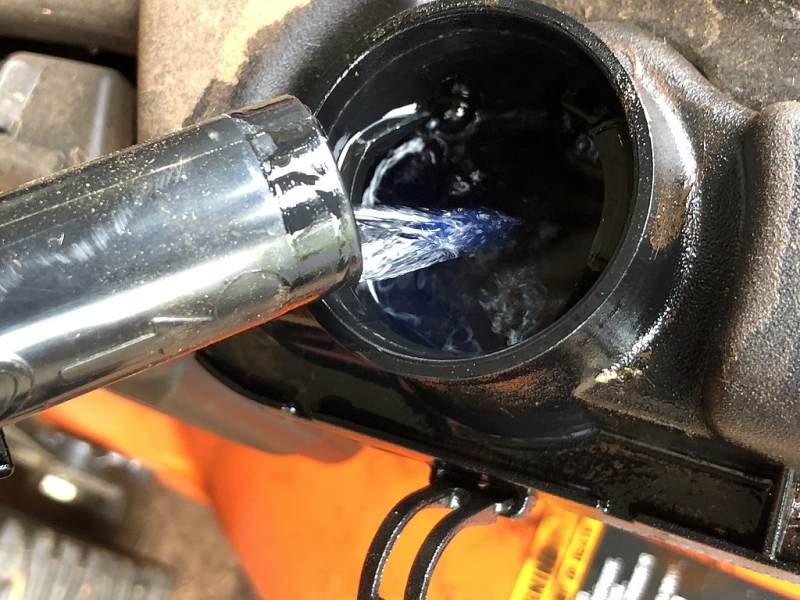
Photo Credit: Famartin / Wikimedia Commons / CC BY-SA 4.0
It’s a good idea to get your lawn equipment ready for the season so you can start your lawn care routine as soon as possible. You should always check your manuals to know which jobs you should do and how often you should do them.
To give you a rough idea, here are a few examples of common lawn care equipment jobs.
Typical gas mower maintenance jobs:
- Changing the fuel
- Changing the oil
- Sharpening and balancing the blade
- Cleaning or changing the air filters
- Lubricating the wheels
- Changing your spark plug
Typical battery mower maintenance jobs:
- Sharpening and balancing the blade
- Cleaning the vents
- Changing the battery
- Lubricating the wheels
You may also need to do maintenance jobs for various other lawn tools, for example:
- String trimmer
- Leaf blower
- Pressure washer
- Riding lawn tractor
- Chainsaw
If you want to make sure that all your equipment is in mint condition, a professional tune-up may be in order.
Recommended time to get started in upstate Ohio: Before mid April
Recommended time to get started elsewhere in the state: Before late March
2. Do a Spring Cleanup
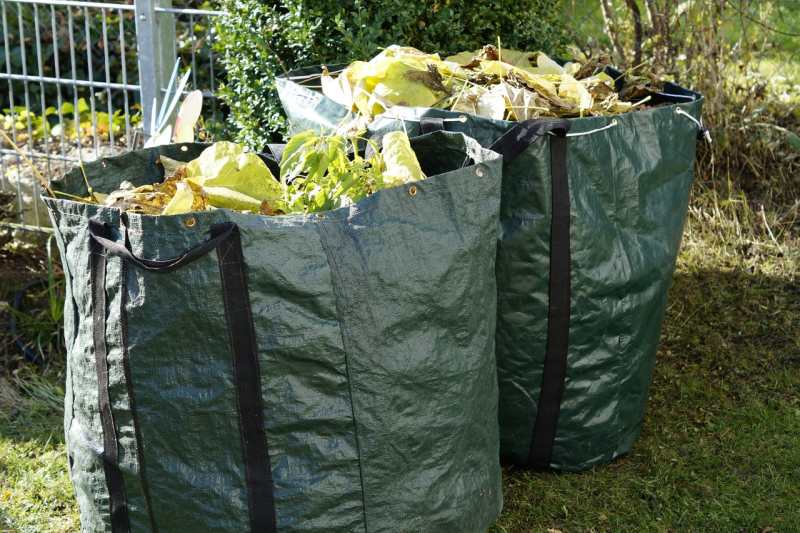
Photo Credit: PxHere
After winter has passed, Ohio experiences a beautiful spring season complete with blooming flowers and trees. However, cold weather and snow usually leave their mark on lawns and gardens, so it’s necessary to do a spring cleanup to prepare them for the growing season. This involves removing debris, pruning trees and shrubs, and raking up dead leaves and grass to promote healthy growth.
When you begin your spring cleanup depends on where you’re based in the state. Make sure you wait until all the snow has melted and the grass has fully dried.
Recommended time to get started in upstate Ohio: Around mid April
Recommended time to get started elsewhere in the state: Around late March
3. Attack Weeds
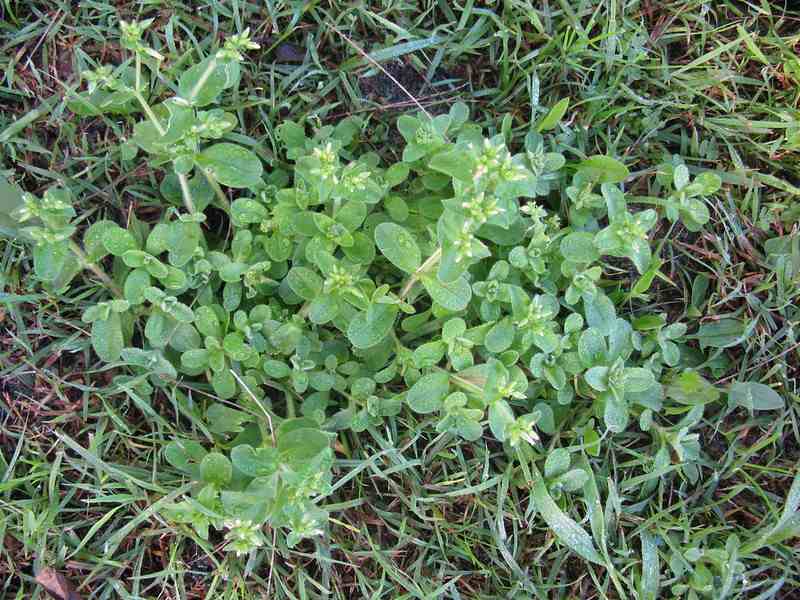
Photo Credit: Harry Rose / Flickr / CC BY 2.0
Weeds can be a frustrating problem, but there are ways to prevent them from taking over. Typical Ohio weeds are:
Mowing and watering is a good start because it keeps the lawn healthy and strong, making it less susceptible to weed growth. But to further prevent and treat weeds, you can consider herbicides.
There are two kinds of herbicides on the market:
- Pre-emergent herbicides are applied before weeds grow to stop them from germinating. Normally lasts 3 to 5 months.
- Post-emergent herbicides are applied to weeds that have already sprouted.
- Selective herbicides target specific weeds and won’t harm other plants.
- Non-selective herbicides target all plants.
- Liquid herbicides are often considered more efficient.
- Granular herbicides may be easier to use and often include fertilizer.
Before you apply herbicide:
- Keep in mind that herbicides are toxic. Follow the product’s instructions to safeguard yourself, your pets, and local wildlife. You can consider using organic herbicide instead, but take note that any herbicide has hazards and you should always proceed with caution.
- When selecting a product, look out for common toxic ingredients.
- Don’t apply herbicides to newly seeded areas; you might damage them.
- Don’t irrigate 24 hours before application.
- Don’t mow your lawn 2 to 3 days before or 3 to 4 days after application.
When to get started? You can get started around mid April in upstate Ohio and around early April elsewhere in the state.
4. Treat for Diseases
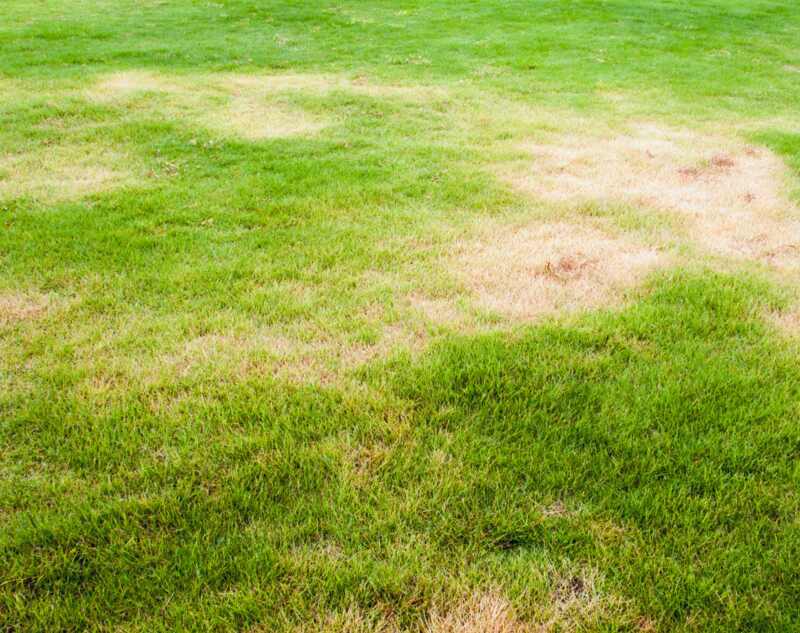
Photo Credit: yuriz / Canva Pro / License
Now that you can (hopefully) wave goodbye to weeds for the season, it’s time to deal with the next common lawn problem: diseases. Once again, you’re less likely to come across lawn diseases if you take good care of your lawn. Make sure that your grass gets enough airflow and sunlight and that you water, mow, and fertilize as needed. You can also apply a preventive fungicide.
Common Ohio diseases include:
You’re more likely to find disease on your lawn if there are any of the following:
- Heavy dew or wet weather
- Warm night temperatures (over 50 degrees)
- Too much moisture
- Infertile soil
- Lawn damage
- Non-resistant grass types
If you do come across a lawn disease, make sure to treat it right away. You may need to use a curative fungicide, replace affected soil and sod, or reseed.
Fungicides are chemicals that can be harmful to people, animals, and the environment, so be sure to follow all instructions and use them responsibly. You can consider organic alternatives, but no fungicide is hazard-free, so it’s important to be careful and follow instructions.
5. Treat for Pests
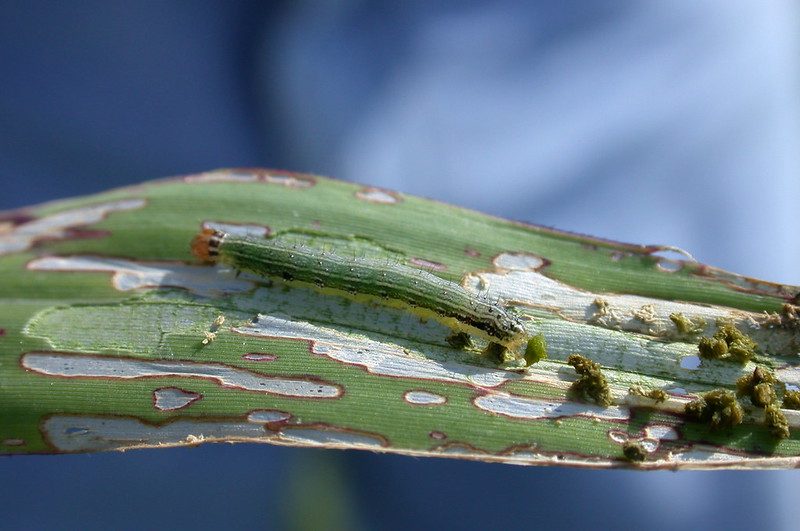
Photo Credit: uacescomm / Flickr / CC0 1.0
Is your lawn disease- and weed-free? Great, but insect pests can still wreak havoc on it. The same rule applies here: take good care of your lawn, and you’ll be less likely to have to deal with them.
However, if you do come across insect pests on your lawn, you should take safe steps to remove them. Here are some of Ohio’s insect pests and how you can get rid of them:
Chinch bugs are often mistaken for a fungal disease. They lay their eggs in the spring, and lay more eggs during hot summer weather. You may notice visible damage from chinch bugs by the end of June or August.
These bugs tend to develop pesticide resistance, so if you suspect that your lawn is infested with chinch bugs, call a professional.
Grubs are bug larvae. They’re likely to appear in March to May, and again in mid-September to November. If they begin to bug your lawn, you may notice dead spots and beetles flying around.
Wildlife like birds, skunks, and raccoons often feed on grubs, but if you still have a problem, you can introduce beneficial nematodes that will eradicate grubs within the next few years. Alternatively, applying the milky spore bacteria is another effective solution, but it will take a while to develop as well.
Sod webworms are lawn-damaging caterpillars. They’re active from spring to fall, but most damage occurs in mid to late summer. You can keep them out by watering and dethatching regularly, but if your grass seems brown and short in some places, and if there are moths flying away when you mow, your lawn is likely experiencing a sod webworm problem.
To get rid of sod webworms, you can use insecticidal soap or beneficial nematodes.
Billbugs pose a problem both as adults and as larvae. Their damage becomes visible in mid to late June. However, there may also be a second generation of billbugs that will cause more damage in late July and August. It’s hard to identify billbug damage unless you spot the bugs themselves, but they will cause your grass to turn brown. If that happens, try pulling out some grass. If it breaks out of the soil line with sawdust-like excrement, billbugs are likely the problem.
Be sure to keep your lawn short, and if you encounter billbugs, target them before they lay eggs. If you spot newly-hatched larvae, get rid of them as soon as possible.
Cutworms curl their bodies around grass blades and plant stems to feed on them. They’re mainly active in the evenings and at night and normally have 1 to 2 generations per year. Adult flights happen at different times throughout the season. Once they become adult moths, they’re harmless to lawns. But if you need to get rid of them while they’re still larvae, you can do so by dropping them in soapy water or crushing them. You can also try bleach-free dish soap.
What about using pesticides? If all else fails, pesticides are your last resort (except in the case of chinch bugs, where you should call professional help right away). Try to use organic pesticides and keep toxicity levels to a minimum. Always follow instructions to protect yourself and your pets.
6. Do a Soil Test
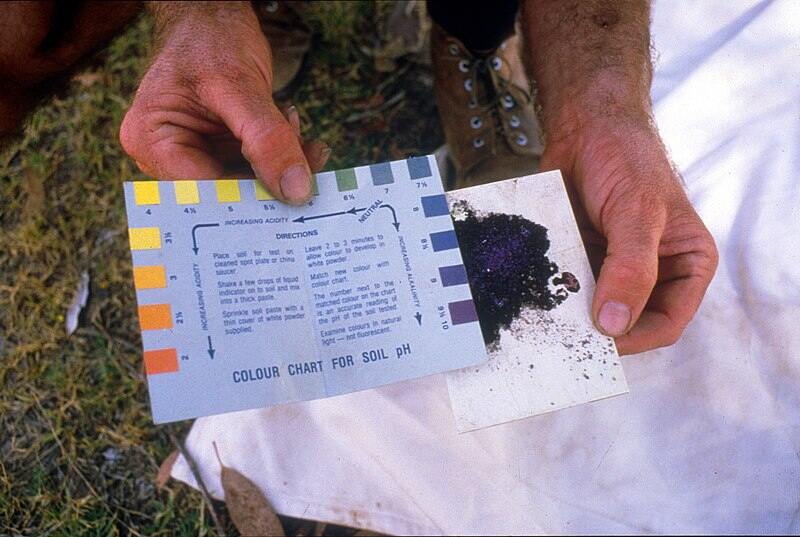
Photo Credit: CSIRO / Wikimedia Commons / CC BY 3.0
In the best-case scenario, you have healthy soil that thrives just fine with regular mowing and watering. However, it’s lawns often lack nutrients and turn lackluster. These lawns get weaker and may even struggle with diseases, weeds, and insect pests.
To ensure your soil has the right balance of nutrients, you should regularly test it and find out if you need to fertilize. The Department of Agriculture recommends testing your soil every two to three years, but if you want to do so more often, you certainly can.
A soil test can tell you your soil’s:
- pH
- Organic matter percentage
- Nutrient levels (P, K, Mg, Ca)
- Micronutrient levels (S, Zn, Fe, Cu, Mn)
- Cation exchange capacity
You can choose between doing a soil test yourself or sending a sample to a lab.
7. Fertilize as Needed
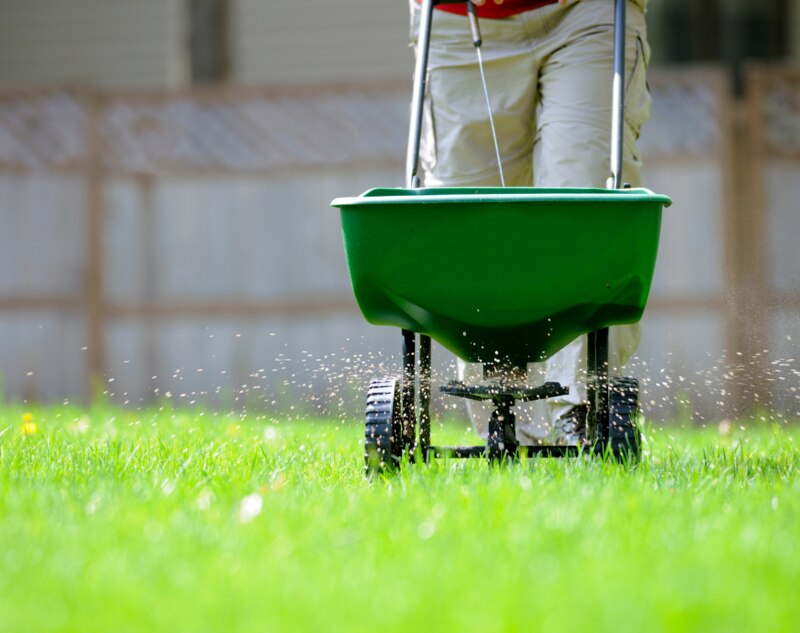
Photo Credit: groveb / Canva Pro / License
If your soil test indicates that you have healthy soil, you can get away with just leaving some nutritious grass clippings on your lawn after each mow. However, if your soil is lacking in nutrients, you may need to fertilize your lawn. Fertilization supplies your lawn with three main nutrients: nitrogen, phosphorus, and potassium.
Here’s what each of these nutrients can do for your lawn:
| Nutrient | Key Benefits |
| Nitrogen | • Helps with rapid growth and protein synthesis • Increases leaf development for dense lawns |
| Phosphorus | • Helps early root growth • Promotes plant maturity and seed development |
| Potassium | • Increases drought and disease resistance |
There are different kinds of fertilizer:
- Organic vs. inorganic: Organic fertilizers are made from natural materials, while inorganic fertilizers are made from synthetic materials. While inorganic fertilizers may be cheaper, they pose a bigger hazard to the environment.
- Dry vs. liquid: Dry fertilizers often come in granular form and are slow-release. On the other hand, liquid fertilizers have to be mixed with water and are usually quick-release.
- Slow-release vs. quick-release: While quick-release fertilizer gives the soil a swift boost, slow-release fertilizer is usually recommended; it provides nutrition over time and is more environmentally friendly.
Using fertilizer poses a hazard both to humans and to animals, so be cautious, use only as much as you need, and follow instructions closely. Organic fertilizer is a good option if you want to reduce the number of chemicals you use on your lawn, but be mindful that any fertilizer can be harmful.
Ohio State University recommends fertilizing four times a year:
- In April
- In late May (or just once in late April to early May if you’ve fertilized in the previous fall)
- In early September
- In early November to early December; ideally late November to early December if you’re based in northern, central, or southern Ohio
If you want to know more, be sure to check out our Ohio fertilizing guide to find out more about Ohio’s best lawn fertilizer schedule.
8. Water Efficiently
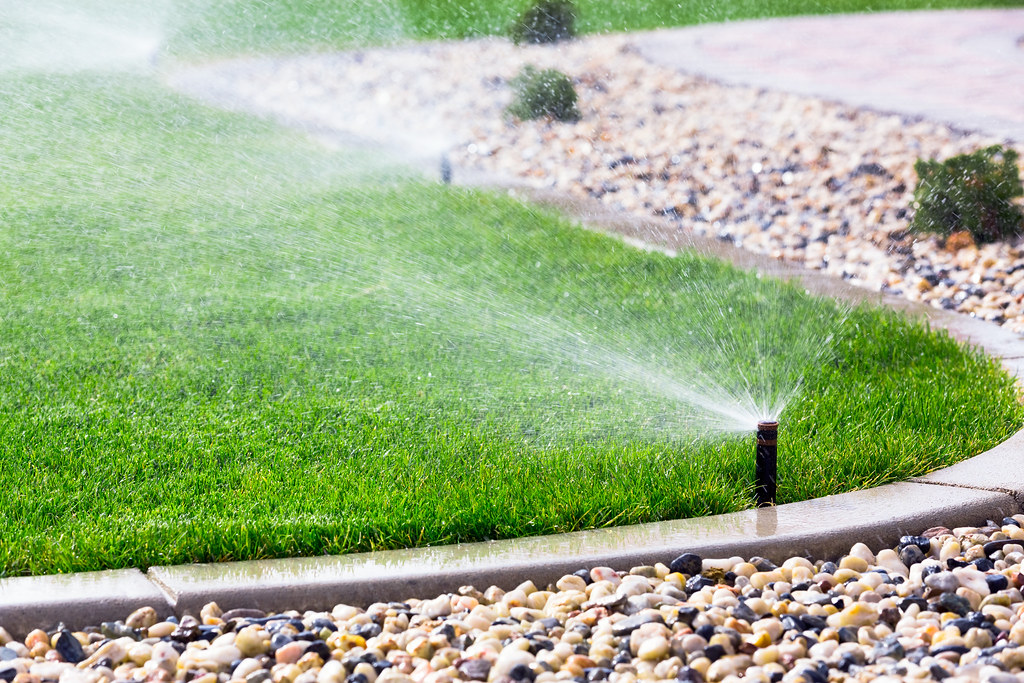
Photo Credit: Aqua Mechanical / Flickr / CC BY 2.0
Grass needs water to thrive, but you don’t want to get ahead of yourself and overwater. There should be plenty of rain in early spring to hydrate your lawn, so keep your hose handy for late spring to early summer, when the weather becomes hot and dry.
Once it’s needed, though, be sure to water efficiently by giving your lawn about an inch of water per week, either through rainfall or irrigation. You should always water before 10 a.m. and not late at night. The optimal times are between 5 and 6 a.m., but if that’s not possible, watering between 4 and 5 p.m. will work, too.
Although watering is important, make sure you don’t overwater. Overwatering can lead to negative consequences such as root rot and the growth of mold and mildew.
When should you start watering? It’s best to observe your grass to determine when it needs water. Signs that your lawn needs watering include:
- Turning to a bluish-gray color
- Wilging
- Grass not bouncing back when you walk on it
9. Mow Your Grass
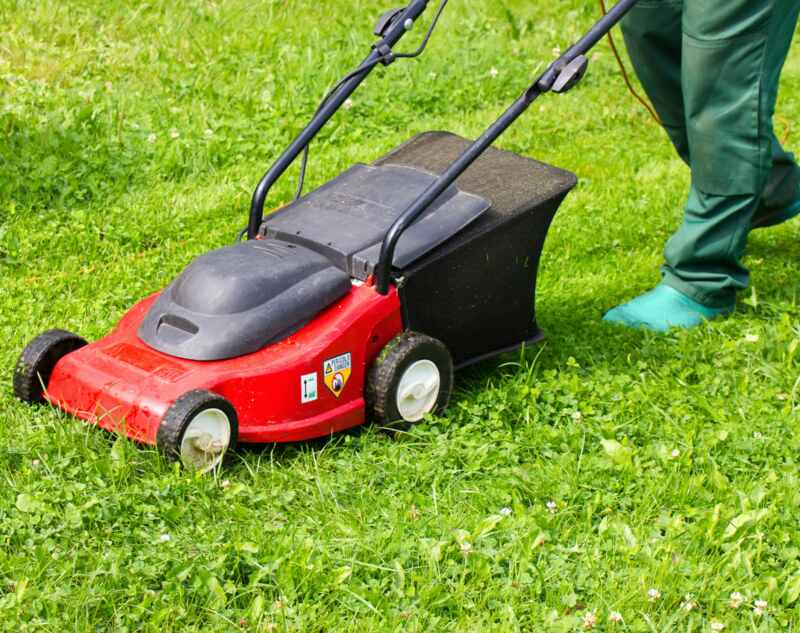
Photo Credit: lutavia / Canva Pro / License
Mowing your grass isn’t as simple a task as it seems. It’s recommended to mow your grass regularly and at the right height to maintain its health and appearance.
See the approximate recommended height for each Ohio grass type below:
| Grass Type | Recommended Mowing Height |
| Kentucky bluegrass | 2.5 to 3.5 inches |
| Turf-type tall fescue | 3 to 4 inches |
| Fine-leaf fescue | 2.5 to 4 inches; the grass is slow-growing, so taller heights may be preferable |
| Perennial ryegrass | 2.5 to 3.5; you can cut even shorter, but very short heights need a reel mower |
Here are some must-know mowing tips:
- Don’t remove more than one-third of your grass in a single mow
- Don’t mow when the grass is wet
- Don’t mow in the heat, and raise your mowing height if your cool-season grasses’ growth rate slows down
- If you leave grass clippings on your grass, be sure not to leave too much and that they’re not stuck together
You can start mowing as soon as your grass grows above 2 inches.
Tip: Mulch your trees before you mow to protect their roots from damage. You only need 2 to 4 inches of mulch, which should start 3 to 6 inches away from the trunk and extend outward 3 feet.
Final Thoughts
If you’ve ticked off all your spring maintenance tasks this year, good job. However, there’s a lot more that goes into maintaining a healthy and thriving lawn. Be sure to learn about how to keep it in lush condition all year round. You can also check out our fertilizing guide to help you decide if and when you need to fertilize.
Are you getting tired just thinking about all the hard work it will take to keep your lawn pretty this season? Get in touch with a lawn care professional who can handle it for you.
Main Photo Credit: LouisvilleUSACE / Flickr / CC BY 2.0